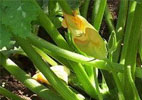Sterols from Cucurbita maxima
Consolacion Y. Ragasa1 and Kathleen Lim
1Chemistry Department, De La Salle University, 2401 Taft Avenue,
Manila 1004, Philippines
corresponding author: This email address is being protected from spambots. You need JavaScript enabled to view it.
ABSTRACT
The flowers of Cucurbita maxima Duch. afforded a 4:1 mixture of spinasterol (1a) and 24-ethyl-5α-cholesta-7, 22, 25-trien-3β-ol (1b). Their structures were elucidated by extensive 1D and 2D NMR analyses. Antimicrobial activity tests on sample 1 indicated that it was slightly active against the fungi (Aspergillus niger and Candida albicans) and the bacteria (Bacillus subtilis and Pseudonomas aeruginosa). It was inactive against Escherichia coli, Staphylococus aureus, and Trichophyton mentagrophytes.

INTRODUCTION
Cucurbita maxima Duch., commonly known as squash is widely used as vegetable and a source of vitamin A, iron, phosphorus, and calcium. A recent study reported that spinasterol from the flower s of C. maxima showed potential anticarcinogenic, antigenotoxic (Villasenor et al. 1996), antimutagenic, and antitumorigenic activity (Villaseñor & Domingo 2000). The seeds were used in the treatment of liver and digestive disorders (Prokhvatilova et al. 1998), while the oil from the seeds exhibited anthelmintic property (Basaran et al. 1998) Earlier studies reported the isolation of cucurbitaxanthin (Zechmeister & Tuzson 1934), gibberellin (Inouye et al. 1991), ent-6α, 7α, 12α-trihydroxykaur-16-en-19-oic acid (Matsuna et al. 1986), α-tocopherol . . . .
REFERENCES
BASARAN AA, CIFTCI KF, KUSMENOGLU S. 1998. Characteristics of Turkish Cucurbita maxima Duch seed oil. Acta Pharmacologica Turc 40(1): 17-19.
BEALE MH, BEARDER JR, HEDDEN P, GRAEBE JE, MCMILLAC J. 1984. Gibberellin A58 and ent- 6α,7α, 12α-trihydroxykaur-16-en-19-oic acid from seeds of Cucurbita maxima. Phytochem 23(3): 565-567.
GUEVARA BQ, RECIO BV. 1985. Phytochemical, microbiological and pharmacological screening of medicinal plants. Acta Manilana Supplements, UST Research Center: Manila. 1985. 81p.
INOUYE Y, WAKAHOI T, SATO S. 1999. N-5(4- methoxyphenyl)methyl-L-glutamine in xylem sap from squash root. Phytochem 51(3): 425-428.
MATSUNA T, TANI Y, MAOKA T, MATSUO K, KOMORI Y. 1986. Isolation and structural elucidation of Cucurbitaxanthin A and B from pumpkin Cucurbita maxima. Phytochem 25(12): 2837-40.
PROKHVATILOVA SS, MIKHALEV V, PROKHOVORA LV, EVTUSHENKO NS, ANTONOVA NP, SIMONOVA EP. 1998. HPLC Determination of α-tocopherol in tykveol preparation. Farmatsiya (Moscow) 47(5): 31-32.
VILLASENOR IM, LEMON P, PALILEO A, BREMNER JB. 1996. Antigenotoxic spinasterol from Cucurbita maxima flowers. Mutat Res 360(2): 89-93.
VILLASEÑOR IM, DOMINGO AP. 2000. Anticarcinogenicity Potential of spinasterol Isolates from Squash Flowers. Teratogenesis, Carcinogenesis, and Mutagenesis 20: 99-105.
ZECHMEISTER L, TUZSON P. 1934. The pigment of Cucurbita maxima Duch. (great squash). Ber 67B: 824-828.









